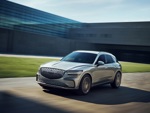By John Messore, freelance tax expert on company cars, vans, fuel cards, mileage and salary sacrifice
In its latest Employer Bulletin, February 2025, HMRC has reminded us that they are withdrawing their concession on double cab pick-up trucks and instead we must go back to basic principles as set out in the Coca Cola European Partners tax case.
As many readers will recall, this case centred on two-panel vans with a removeable row of second seating.
At the First Tier Tribunal (FTT) the judge established the fact that he thought the Vauxhall Vivaro had been of a construction primarily suited to the conveyance of goods and so was a ‘van’, whereas the VW Kombi was not, and therefore was a car.
That decision was upheld at the Upper Tribunal.
I actually agree with these decisions since the vehicles are fundamentally different, e.g. one had one rear view window, the other had two.
At the Court of Appeal, both sets of barristers wanted the same outcome for both vehicle types. A high stakes game of double or quits, if you like.
The judges found it necessary to have to reverse one of the FTT decisions and in the end they flipped the Vivaro from a van to a car.
To justify its decision it had to explain why the lower courts had erred and so put their own spin on the meaning of legislation, but there are still contradictions in the judgement and there are definitely contradictions in HMRC’s interpretation of that judgement.
For example, at no point in that case does it say the minute you have a second row of seats it automatically becomes a car for tax purposes.
The judges’ main argument was ‘primarily means something more than suitability which is first in the list by a whisker. It means first and foremost. It cannot encompass very narrow margins. It is also possible for a multi-purpose vehicle to have no primary suitability at all. The UT and the FTT, therefore, proceeded based on an error of law’.
As stated above they said this in the context of a case where both opposing parties wanted the same outcome for both vehicles. Had the barristers not asked for that the Court of Appeal may simply have upheld the earlier decisions.
Secondly, they were looking at two specific vehicles; the Kombi and the Vivaro.
Notwithstanding legislative interpretations, you still have to look at the facts of each case and the actual vehicles. It is quite possible and plausible that had another vehicle been the subject of the litigation it may well have come out as a van.
That case was not the one and only blueprint which HMRC states that it is and so you still have to look at each vehicle on its own merits.
It is also clear to me having worked in tax for 30 years that had van BIK (benefit-in-kind) tax been higher than car BIK tax then HMRC would have definitely argued the complete opposite interpretation of the law.
We saw one Freudian slip up by HMRC’s barrister when she said that “construction” in the definition of “goods vehicle” means nothing more than the physical features of the vehicle as it stands at the time of the charge to tax and that one must assess the construction in the context of suitability for a purpose.
She says that one should look at the purpose of that construction in terms of the use which it was intended to perform. What is the vehicle's functionality as it stands?
In other words, if a vehicle had been constructed by a manufacturer as a trade vehicle specifically designed to carry goods then surely that makes it a van.
There are many laws with which vans have to comply particularly around heal hand safety and for insurance purposes and these vehicles would have been built with those goods vehicles’ legislation in mind.
The judges also said: “It also follows that I agree with Ms McCarthy that when seeking to carry out an evaluation, it is misleading to look at each feature of a vehicle separately and to determine whether that feature is more typically found in one type of vehicle or another.”
That argument can easily be turned against them by saying that simply because a vehicle has two rows of seats – as typically found in ‘cars’ it does not mean you can put too much weight on that and you still have to look at the overall construction.
Turning to double cab pick-ups, in its latest bulletin HMRC justifies its decision to treat all double cab pick-up trucks as cars because of their own internal manual EIM23151 - Car benefit: double cab pickups 6 April 2025 onwards – which by the way has no statutory weight.
The EIM states you must observe the application of the “primary suitability” test in S115 ITEPA.
But if you read S115 I will give £100 to the first person to find the word ‘suitability’.
No. Section 115 says “goods vehicle” means a vehicle of a construction primarily suited for the conveyance of goods or burden of any description.
First, suited and suitability are not the same thing and I am forever frustrated when HMRC simply change words and use words which are not in the legislation.
Second, the word suited is a qualification of the word ‘construction’ as implied by the FTT.
Third, you have to look at the facts of each case and panel vans and pick-up trucks are not the same thing.
If we go back to the FTT, in deciding that a Kombi was a car they said that the Kombis shared many of the features of the Vivaro, but that those basic design characteristics were also found in other Volkswagen vans such as the Shuttle and the Multivan, which were “essentially minibuses designed to carry passengers”, and that those vehicles “were of a construction primarily suited to the carriage of passengers, even if the original design characteristics may have made them somewhat ‘over-engineered’ for that purpose”.
If we take that same argument then the original pick-up trucks had just one row of front seats given that every vehicle has to have a driver.
As the vehicle evolved a second row of seats was added. Finally rear doors were added. But the underlying chassis was still that of the original pick-up truck which is undeniably a ‘goods vehicle’ as defined in tax legislation – i.e. not a car.
Furthermore were it not for the tax advantages of a van over a car I cannot see any self-respecting employee choosing a pick-up truck as their family car.
Tax motivation should not cloud or colour what a vehicle truly is.
And if you work on a farm, say, then the only suitable vehicle with which to do your job of carrying heavy goods across a field is to use a pick-up.
It is clearly a goods vehicle notwithstanding that it may have two rows of seats, primarily to carry co-workers to help with loading and unloading sheep, bales of hay etc.
If the same vehicle appears in suburbia rather than a field it does not change its character and so to my mind is still a vehicle of a construction primarily suited to carry goods or burden, i.e. it is a ‘van’ for tax purposes.
Unfortunately, the law is defective in that it is still ambiguous and subjective, and each case has to be looked at on its own facts, which is why it is wrong of HMRC to try to have a one size fits all approach.
The previous HMRC one-tonne concession aligning the tax rules with the VAT rules made perfect sense and gave clarity. Now that clarity has gone.
The Court of Appeal judges also stated: “It seems to me that it is clear that the use of ‘primarily’ imports something more than a suitability which is marginally greater than another or any number of other suitabilities”.
In my judgment, therefore, the UT was wrong to conclude that “if a vehicle is of a construction marginally more suitable for the conveyance of goods than it is for any other use, its ‘primary suitability’ is that of conveying goods”.
‘Primarily’ requires more than a percentage point advantage of one suitability over another.
To put the matter another way, in my judgment, the natural and ordinary meaning of ‘primarily’ requires the decision-maker to determine what the vehicle in question is first and foremost suitable for.
Its suitability must be considered in the round and is not merely the produce of a mechanical or mathematical exercise.
Unfortunately, they used the mathematical exercise to convince themselves the Kombi and Vivaro Panel vans were cars because the FTT and UT split the vehicles into three parts, front, mid and rear and said that because the front was used by passengers and the mid could also be used by passengers – only the final third was primarily or exclusively only for goods.
I think a new definition in law would help and I would suggest one looks at floor area (not including the footwells) and if more than half the area is for carry people then it should be a car but if more than half the area is for carrying goods then the vehicle is a van.
At least such an approach would be easy to administer and easy to police. Granted some double cab pick-ups may fail that test and so be classed as cars but many others – particularly with larger areas and payloads (say one-tonne) may well hit that criteria and stay as vans.
Twelve years ago, I alone advised Willmott Dixon to put in their RME (relevant motoring expenditure) claim when other advisers were advising Willmott Dixon to withdraw its claim, saying it would never win.
Ten years later I was vindicated when I won at FTT and UT, indeed so convincingly that HMRC decided not to appeal further and had to issue new guidance pointing out that all their guidance for the prior 20 years was wrong and opening the floodgates for millions of UK taxpayers to submit retrospective NIC refund claims (which many have still not done).
Privately, I hope that some readers will have the courage to continue reporting double cab pick-ups on their P11Ds as vans on the basis that they genuinely and consciously believe that those vehicles are of a construction first and foremost suited to the carrying of goods.
I believe there is a good chance that if this were ever tested in court the taxpayer could win.
The clue to me is in the name. It’s a pick-up truck.


















Login to comment
Comments
No comments have been made yet.